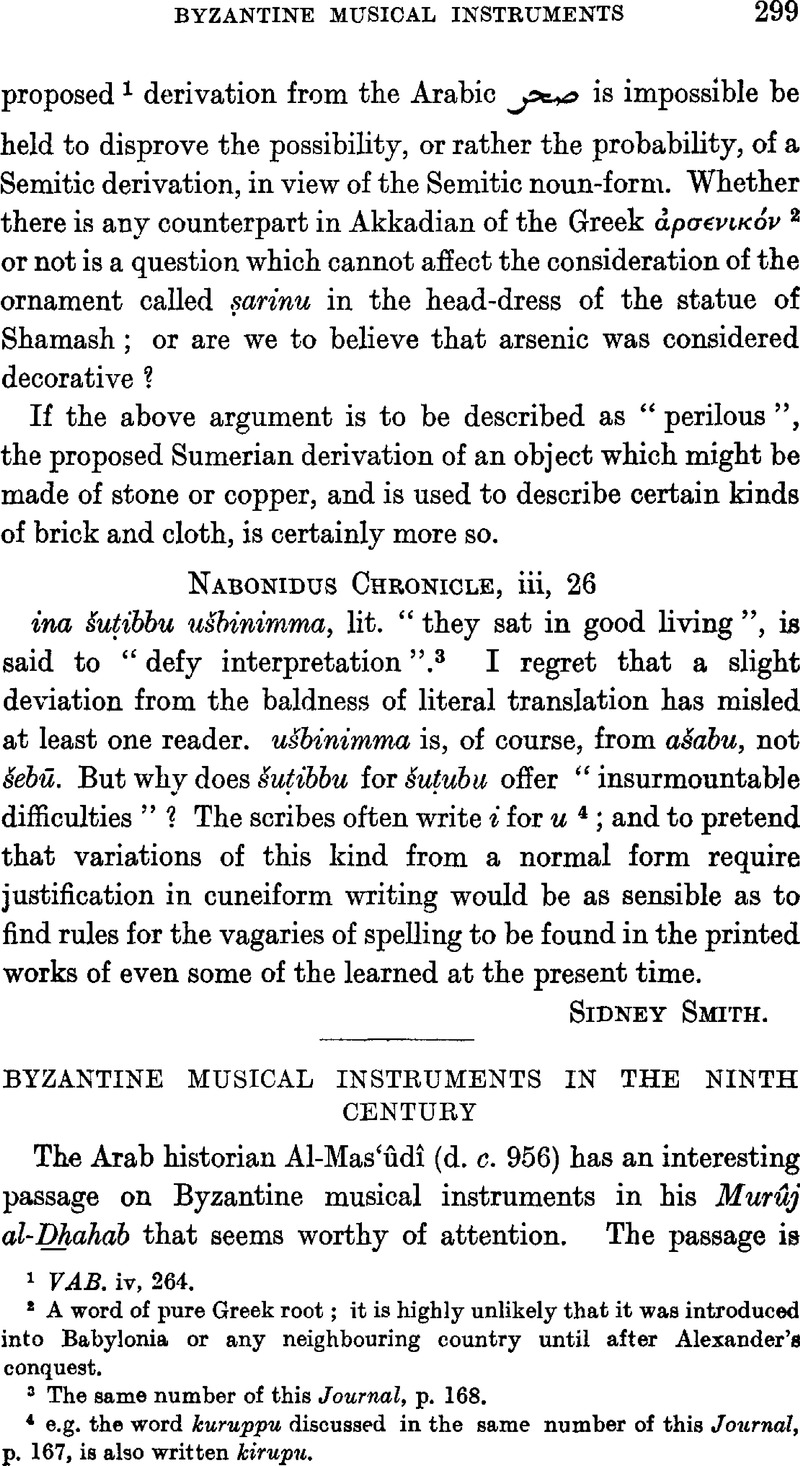No CrossRef data available.
Published online by Cambridge University Press: 15 March 2011

page 300 note 1 Al-Fihrist, 149. The last-named work has survived, but unfortunately in a private collection, that of Ḥabîb Afandî al-Zayyât of Alexandria, Egypt (Al-Hilâl, xxviii, 214), and, despite inquiries, I have been unable to obtain the slightest information concerning its contents.
page 300 note 2 Jour. Asiat., Mai-Juin, 1865, p. 474.
page 300 note 3 Al-Ma ![]() riq, xvi, 444. Al-Fihrist, 27; Ibn Khallikân, ii, 315.
riq, xvi, 444. Al-Fihrist, 27; Ibn Khallikân, ii, 315.
page 300 note 4 De Meynard in Prairies d'or, viii, 417–19.
page 301 note 1 Prairies d'or, viii, 91–2.
page 302 note 1 Dozy, Freytag, Vullers, and Lane use a ![]()
page 302 note 1 Libros del saber de Astronomia del Rey D. Alfonso X de Castille (Madrid, 1863 seq.), 13, zuliaca, 31.
page 303 note 1 It occurs to me that the two-millennium-old controversy concerning the organ called magrepha in the Talmud (‘Arakin, ii; Sukka, v) might be settled by the recognition of this nickname for the organ.
page 303 note 2 Iḵẖwân al-Ṣafâ (Bombay Ed.), i, 92.
page 303 note 3 Al-Fihrist, i, 270.
page 303 note 4 Al-Ma![]() riq, ix, 21.
riq, ix, 21.
page 303 note 5 Al- ![]() wârizmî, Maf^tiḥ al-‘Ulûm, 236. Professor E. Wiedemann (Beitraege zur Geschichte der Naturwissenschaften, lxvi; Sitzungsberichte der physikalisch-medizinischen Societaet in Erlangen, liv) writes qîṭâra instead of qîtâra. The form does not occur in Van Vloten's edition of the Mafâtîḥ al-‘Ulûm, but see Villoteau, Déscription historique … des instruments de musique des orientaux, 919.
wârizmî, Maf^tiḥ al-‘Ulûm, 236. Professor E. Wiedemann (Beitraege zur Geschichte der Naturwissenschaften, lxvi; Sitzungsberichte der physikalisch-medizinischen Societaet in Erlangen, liv) writes qîṭâra instead of qîtâra. The form does not occur in Van Vloten's edition of the Mafâtîḥ al-‘Ulûm, but see Villoteau, Déscription historique … des instruments de musique des orientaux, 919.
page 304 note 1 No Arabic form of the word organ is given by Dozy, but the above forms may be found in : IḴẖwân al-Ṣafâ, loc. cit. ; Al-![]() wârizmî, op. cit., 226 ; Ibn Sînâ, loc, cit. ; Fa
wârizmî, op. cit., 226 ; Ibn Sînâ, loc, cit. ; Fa![]() r al-Dîn al-Râzî, Brit. Mus., Or. 2972, fol. 154 v. ; Kitâb al-A
r al-Dîn al-Râzî, Brit. Mus., Or. 2972, fol. 154 v. ; Kitâb al-A ![]() ânî, ix, 95 ; Burhân-i-Qâṭi’, sub voce; Bibl. Geog. Arab., loc. cit. ; Al-Ma
ânî, ix, 95 ; Burhân-i-Qâṭi’, sub voce; Bibl. Geog. Arab., loc. cit. ; Al-Ma ![]() riq, ix, 18 ; Ibn
riq, ix, 18 ; Ibn ![]() aibi, Bodl. Lib., No. 1842, fol. 77; Notices et Extraits, xxxviii, 30, 38 ; Gloss. Lat.-Arab., 357, 563 ; Walton's Poly. Bibl., Psalm cl.
aibi, Bodl. Lib., No. 1842, fol. 77; Notices et Extraits, xxxviii, 30, 38 ; Gloss. Lat.-Arab., 357, 563 ; Walton's Poly. Bibl., Psalm cl.
page 304 note 2 In the eleventh century Glossarium Latino-Arabicum, edited by Seybold, the term organica equates with “ possessed of many strings ” ![]() , which reminds us of Plato's phrase. For a corresponding usage in Western Europe see Boethius, De musica, i, 34, and the Mon. Germ. Hist., ii, 101.
, which reminds us of Plato's phrase. For a corresponding usage in Western Europe see Boethius, De musica, i, 34, and the Mon. Germ. Hist., ii, 101.